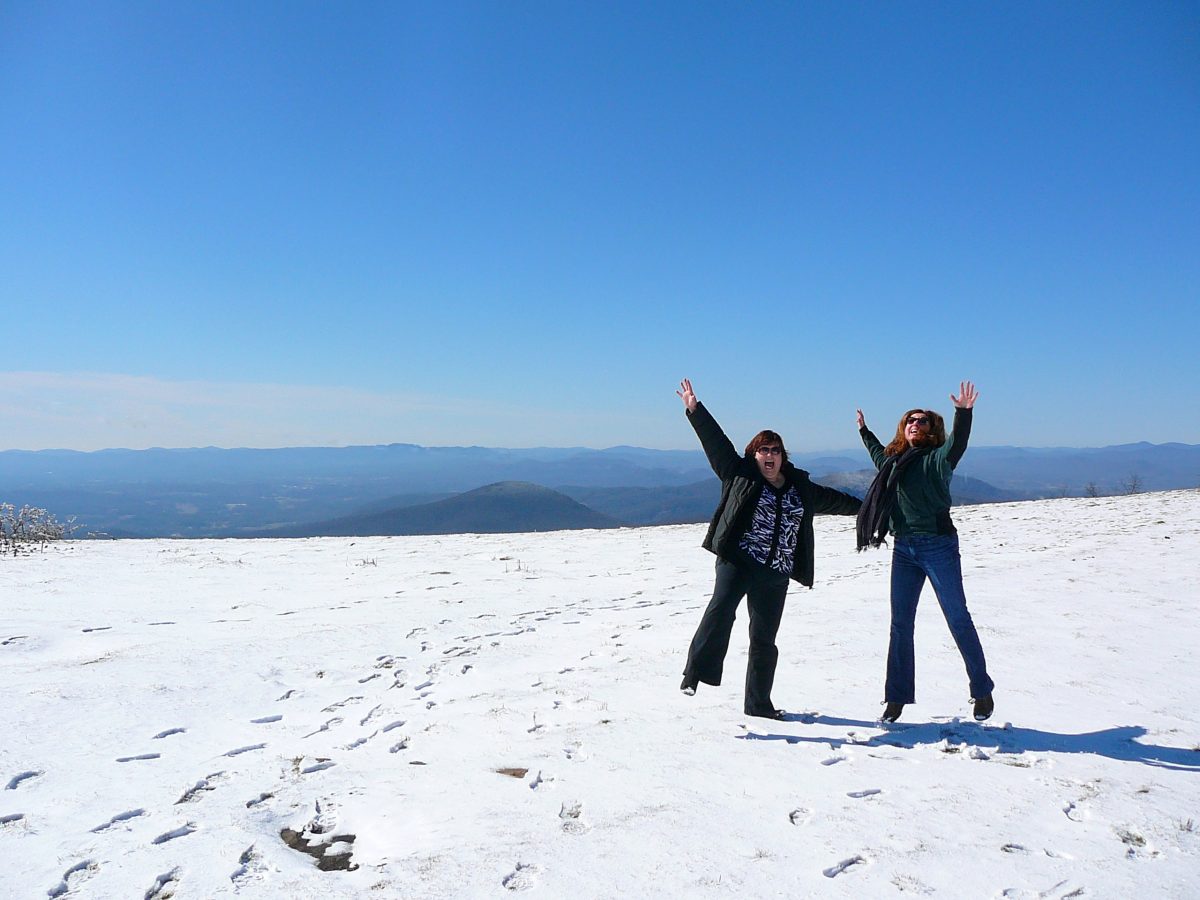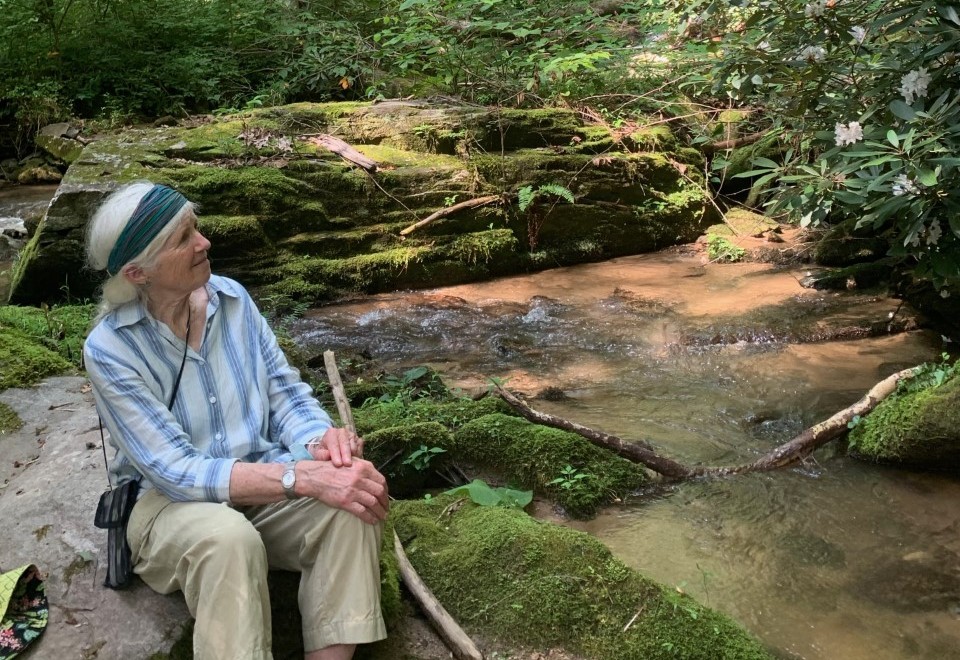There are all kinds of ways to enjoy the great outdoors! In the Flying Squirrel Outdoor Challenge, we invite you to explore 8 places that Conserving Carolina has helped protect or open to the public. Unlike our White Squirrel Hiking Challenge, it’s not all about hiking. You can choose if you want to go for a walk, have a picnic, watch birds, ride a bike, paddle a river, take the kids to a playground, or do your own thing. You can discover natural areas near you or venture further out.
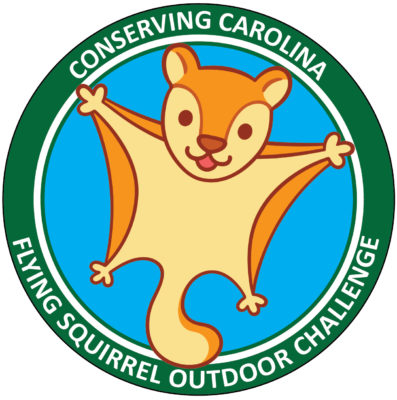
To complete the Flying Squirrel Outdoor Challenge, pick any 8 outdoor destinations from the list below. Your options include 8 places that are accessible to people with disabilities so the challenge is open to people of all abilities. Everyone is welcome to participate, but you must be a Conserving Carolina member to earn your Flying Squirrel patch.
We’d love to see how it’s going, so please share your stories and photos on social media with the hashtag #flyingsquirrelchallenge. Our new Facebook group, the Conserving Carolina Community, is a great space for sharing your stories with other folks who love conservation and the outdoors.
If more challenging hikes are your thing, you can also check out our White Squirrel Hiking Challenge. Or do both!
Choose Your Eight Outings
Here’s a list of the activities and venues you can choose from, with more detailed information below. Please note that only outings you’ve taken after Jan. 1, 2021 count toward this challenge.
- Sassafras Mountain
- The Park at Flat Rock
- Connestee Falls
- The French Broad River
- Cane Creek Greenway
- Vaughn Creek Greenway
- Hooker Falls
- Oklawaha Greenway
- Carolina Memorial Sanctuary
- Brevard Bike Path
- Bearwallow Mountain
- Any Outdoor Volunteer Day
- Any Forest Bathing Walk
The Flying Squirrel Challenge is brought to you by DD Bullwinkel’s Outdoors, in Brevard, NC. Thank you, DD Bullwinkel’s, for supporting conservation and connecting people with the great outdoors!

Keep Us in the Loop!
We’d love to hear about your hikes. Please share pics on Facebook, Instagram, or Twitter, tag Conserving Carolina, and use the hashtag #flyingsquirrelchallenge. We’re excited to see where this takes you.
How to Take the Challenge
It’s simple. Here’s how it works.
- You don’t need to do anything to sign up. Just use this link to log your first outing.
- Log each outing as you complete it. You can check your progress in this roster.
- You can do the outings at your own pace. You can take weeks, months, or over a year—whatever works for you.
- Only outings that you’ve done after Jan. 1, 2021 count toward the Flying Squirrel Challenge.
- You can complete the outings on your own or as a group.
- If you’ve completed all outings and you are a Conserving Carolina member, congratulations! You are a Flying Squirrel champion. You will receive an award package, including your Flying Squirrel patch and a certificate of completion.
The Outings
Choose any 8 outings from this list. You can do the activities in any order and at your own pace. As you complete them, log your challenges here. That’s how you move closer to becoming a Flying Squirrel Champion!
1. Sassafras Mountain
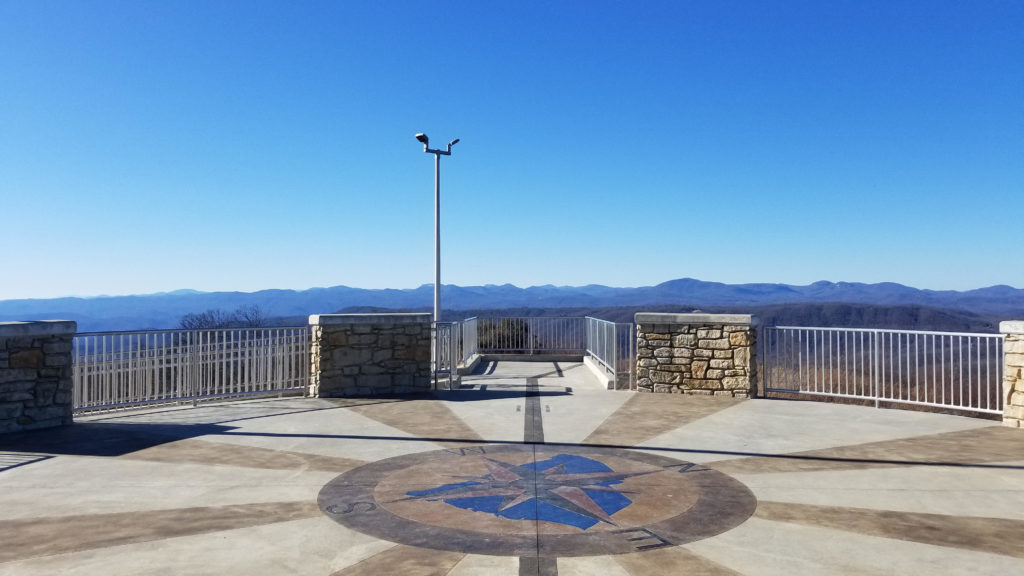
You can enjoy breathtaking views from the highest point in South Carolina with a very short walk from the parking lot—only about a quarter mile. The Sassafras Mountain Overlook is near the NC/SC state, between Pickens, SC and Rosman, NC. The beautiful viewing platform near the parking area overlooks sweeping vistas over Upstate South Carolina, as well as the 6,370-acre Headwaters State Forest, which Conserving Carolina helped protect. Headwaters is North Carolina’s newest state forest, just opened in 2018. If you want to go for more of a walk while you’re out there, you can continue on the Foothills Trail or check out another hike in Headwaters State Forest.
While there are ramps leading to the platform, the steep gravel path before you get to the ramp may present challenges to some people with disabilities.
2. The Park at Flat Rock

Accessible to people with disabilities
You might see more wildlife than you’d expect in this 66-acre local park owned by the village of Flat Rock. Among its clear streams, ponds, and meadows, you might spot bluebirds, monarch butterflies, box turtles, great blue herons and other animals. Conserving Carolina helped to create the park, which was formerly a golf course. The park opened in 2015.
This is a great place to enjoy a wide range of activities. You can watch birds, walk dogs, enjoy a bench in the shade, or throw a ball or frisbee. Kids will love the large nature playground and designated “tot lot” for children under five. Stop by the pavilion at the Maybank-Rhett Nature Center to learn about local flora and fauna, or look for pollinators in the meadow and butterfly garden.
3. Connestee Falls
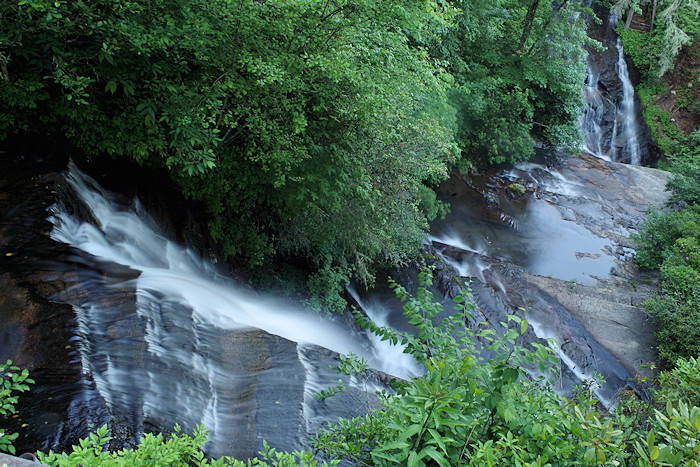
Accessible to people with disabilities
Connestee Falls is a beautiful, 85-foot waterfall near Brevard that can be visited and enjoyed by people of all abilities. There’s a 50-foot handicap-accessible boardwalk that leads to a viewing platform that overlooks not one but two lovely waterfalls—Connestee Falls and Batson Creek Falls.
Conserving Carolina protected the property with a conservation easement in 2003 and later transferred it to Transylvania County, to create a small local park. The short boardwalk is the extent of the walking trails. But, if you’d like to visit another waterfall in the area, you can get a beautiful roadside view of Glen Canyon Falls about six miles away.
4. The French Broad River- float or fish!

Did you know we’re bringing back wildlife habitat that was lost along the French Broad River? Through a series of ambitious restoration projects, we’ve helped regrade crumbling riverbanks, uncover a buried wetland, restore rare mountain bogs, and create much-needed habitat for muskie (our largest native fish). Hopefully, you’ll see more fish, birds, insects, amphibians, reptiles, and mammals along the river as a result! We invite you to get out on the French Broad and look for wildlife as you tube, kayak, canoe, or paddleboard. Or cast a line from the riverbank and try your luck with the fish.
For this part of the challenge, you can choose any part of the river from the headwaters in Rosman as far downstream as Asheville. If you’d like a specific recommendation, try putting in at the Horse Shoe River Access Park that Conserving Carolina helped create in 2016. Here’s a description of potential paddle routes from that put-in.
5. Cane Creek Greenway
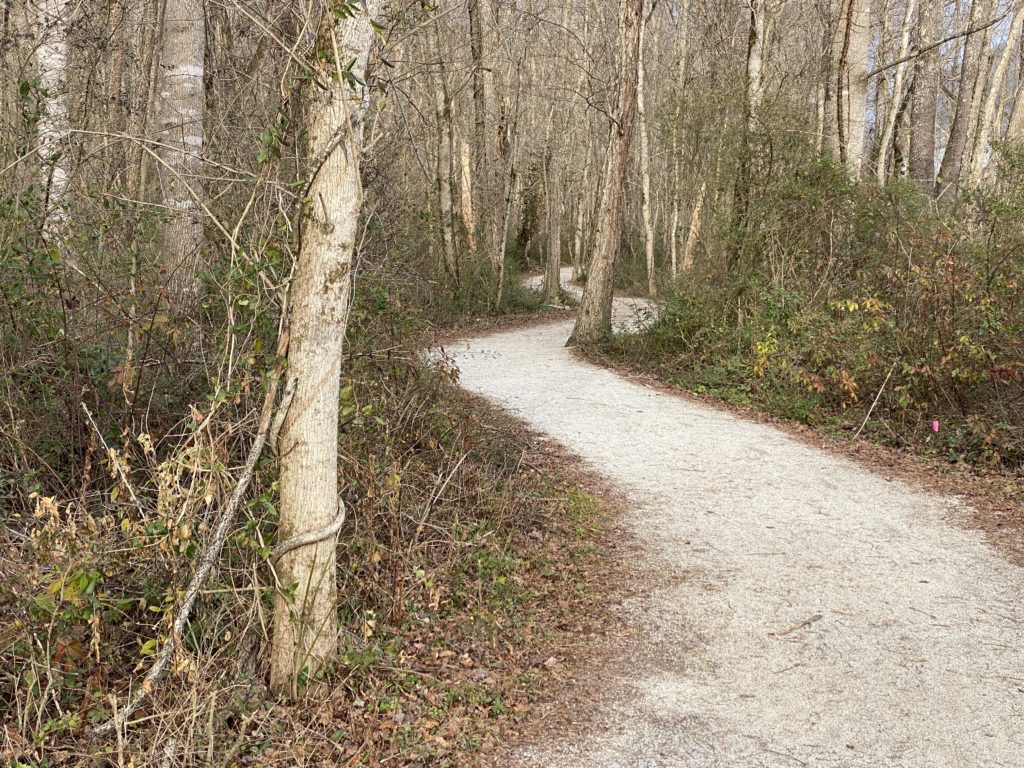
Accessible to people with disabilities
The Cane Creek Greenway in Fletcher offers three miles of level trails beside the rippling waters of Cane Creek. You can walk, run, or bike on the greenway, or enjoy the amenities of the adjacent Bill Moore Community Park. The park includes sports fields, a playground, a disc golf course, arboretum gardens, a picnic shelter, and a dog park. Conserving Carolina helped create the greenway, as well as restore the creek to reduce erosion and improve wildlife habitat. From interpretive signs along the greenway, you can learn about the stream restoration and the natural environment, including a special plant known as rivercane, a kind of native bamboo used in traditional Native American baskets and crafts. Cane Creek is named for rivercane, which you can find growing along the greenway.
(BTW, you might notice that the signs refer to Carolina Mountain Land Conservancy. That was us—one of the two land trusts that merged in 2017 to form Conserving Carolina.)
6. Vaughn Creek Greenway
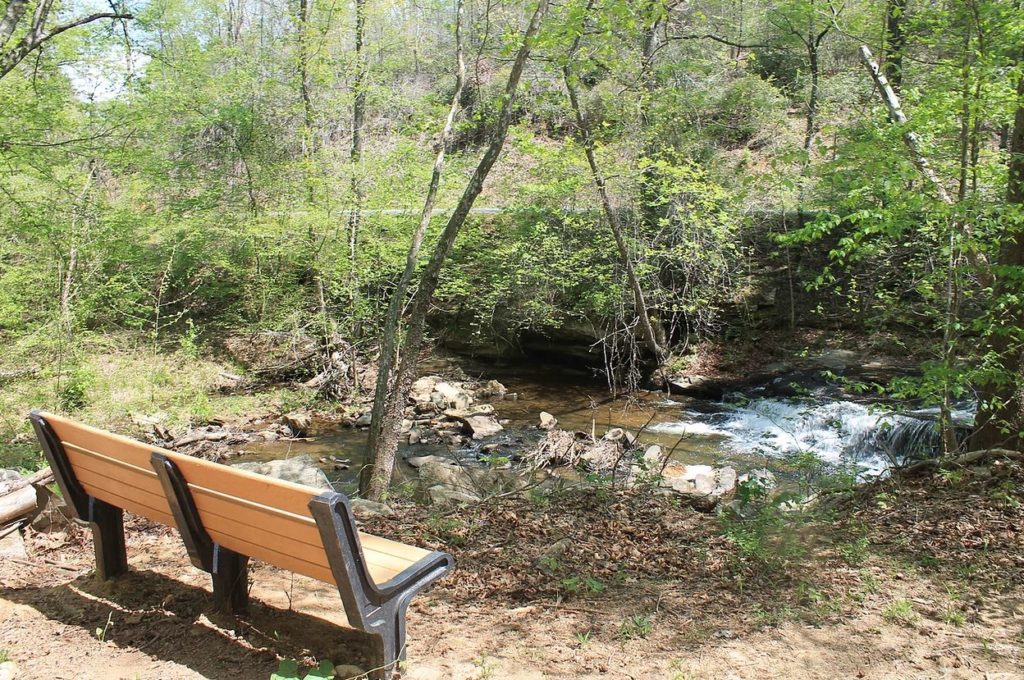
Accessible to people with disabilities
There’s much to enjoy along this 0.8 mile unpaved greenway near Tryon, including a lovely waterfall! There are plenty of benches and picnic shelter along the easy, wooded path. It’s a great place to walk or run beside the creek, and a great place to get out with your dog. A short path takes you from the picnic shelter to the 6-foot tall Sillers Falls where kids (and adults) can splash on a summer day. Enjoy trout lilies and other wildflowers in the spring.
Conserving Carolina helped secure the land for the greenway, construct the trail, restore the stream, and manage invasive plants, so you can enjoy a beautiful creekside path. We also protect a number of properties along the greenway, keeping this a natural, undeveloped corridor.
7. Hooker Falls
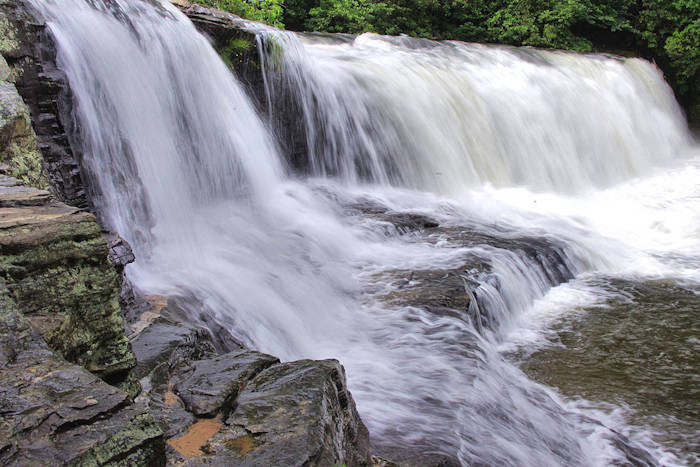
Observation deck is accessible to people with disabilities
Hooker Falls is one of a series of stunning waterfalls in DuPont State Recreational Forest. Accessible from a 0.3 mile hiking trail, it’s a great place to bring the family and a popular swimming spot in the summer. This site can get crowded, so you may want to plan your visit early or late in the day, or on a weekday. Park at the Hooker Falls access area on Staton Road. While the trail down to the waterfall is not handicap accessible, there is an accessible paved path from the parking area to an observation deck with a view of this beautiful waterfall.
Conserving Carolina is proud to have played a key role in protecting thousands of acres in DuPont State Recreational Forest—including the new 717-acre Continental Divide Tract. If you’re in the mood a waterfall extravaganza, DuPont has plenty more to offer, including Triple Falls, High Falls, and Bridal Veil Falls.
8. Oklawaha Greenway
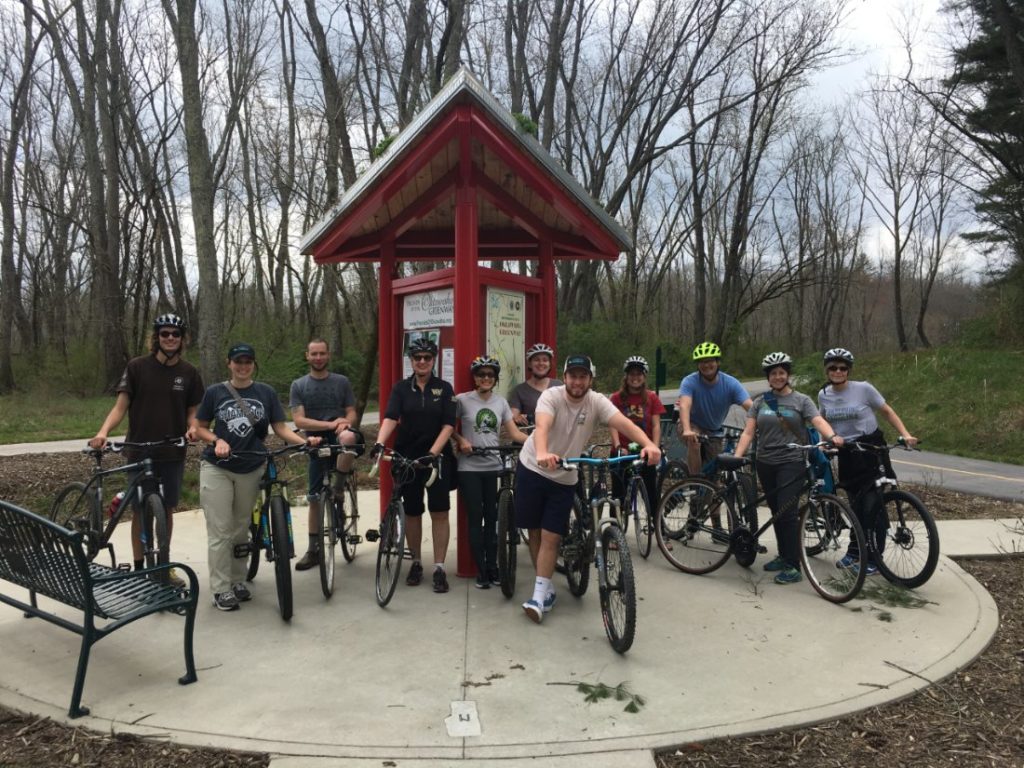
Accessible to people with disabilities
A great place to walk, run, or bike near Hendersonville, the 3.5 mile greenway is fully paved with a gentle grade. And there’s so much nature to enjoy! The greenway passes by wetlands, meadows, and forests as it follows Mud Creek, a tributary of the French Broad River. The Audubon Society has named this greenway as a birding “hot spot” and you can also see beautiful seasonal wildflowers. The greenway is accessible from five convenient parking areas. Take your pick and enjoy the greenway! One thing to note is that some greenway sections do flood in wet weather.
Conserving Carolina is a founding member of the Friends of Oklawaha Greenway, and we hold regular trash pick-ups to keep the greenway clean. We’re also working to continue adding new segments to the greenway, including a potential section through our Mouth of Mud Creek floodplain restoration.
9. Carolina Memorial Sanctuary
Accessible to people with disabilities
You might not always think of a cemetery as a place to go for a walk, but Carolina Memorial Sanctuary in Mills River is unique. Offering green burials on land forever protected by Conserving Carolina, it’s the first conservation burial ground in North Carolina. And more than that, it’s the site of an amazing restoration project! We worked with the sanctuary to bring back a wetland that had been buried under 16 inches of fill dirt! The restored wetland is now home to many kinds of waterfowl, songbirds, salamanders, frogs, and more.
The accessible gravel trails at the sanctuary are open to the public from dawn to dusk. Here, death is a part of life, and you can take in the vitality and serenity of the land as it revitalizes. You can watch birds and other wildlife in the restored wetland. The restoration at the 11-acre sanctuary also includes a stream, woodlands, and meadows. Once overrun with invasive plants, the land is now full of beauty and life. (By the way, if you are interested in conservation burial, here’s how to get a discount through Conserving Carolina.)
10. Brevard Bike Path
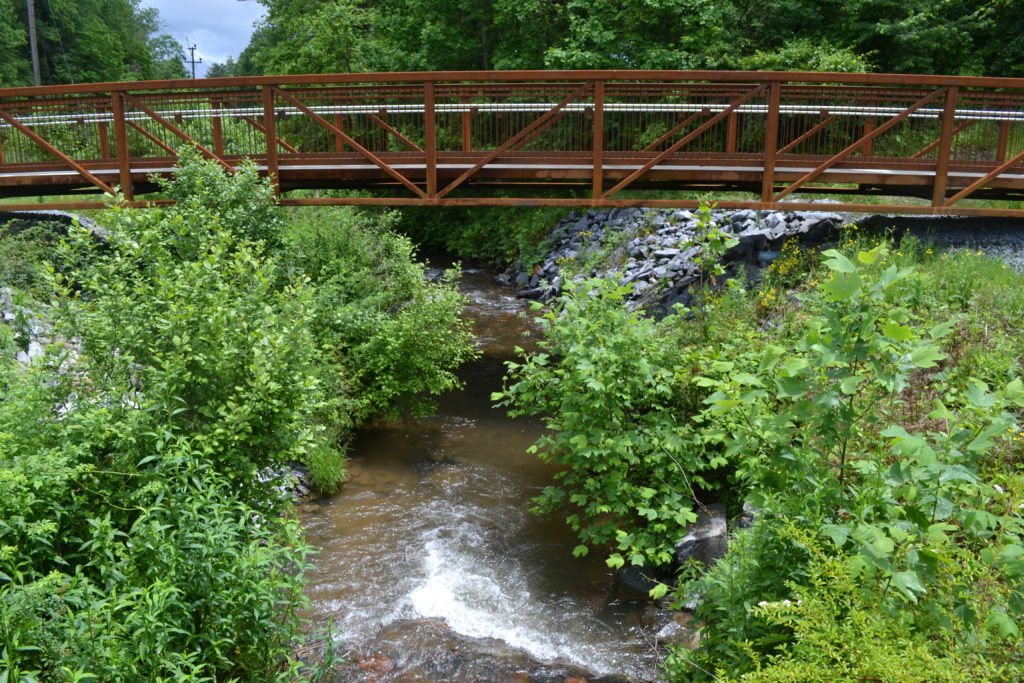
Accessible to people with disabilities
The Brevard greenway system connects downtown Brevard with Pisgah National Forest and a future extension is planned to link to the Bracken Mountain Preserve. The greenway system includes nearly 6 miles of mostly paved trails where you can walk, run, or bike. In addition, you might want to stop in at some downtown businesses or check out the bird sanctuary behind the hospital. You might also be interested in the African-American Storyline, a historic signage project in the Rosenwald neighborhood, where a future greenway extension is planned.
Conserving Carolina has partnered with the City of Brevard to expand the greenway, including the section to Rosenwald. In addition, we organized the Friends of Brevard Area Trails, a volunteer group that helps keep the greenway clean and has helped create new trails in the nearby Bracken Mountain Preserve. Here’s a map of the current greenway route.
11. Bearwallow Mountain
If you’re up for the one-mile hike to the top of Bearwallow Mountain, you’ll be rewarded by nearly 360-degree panoramas from the open pastures on the summit. (That’s two miles round trip.) You can take in gorgeous views of Mt. Pisgah, Hendersonville, the Hickory Nut Gorge, and the Black Mountains. Bearwallow is a wonderful place to enjoy a sunset, bring a picnic, fly a kite, take photos, or hike by moonlight. Kids love to run and play on the wide-open mountaintop.
Bearwallow Mountain is actually a working farm protected forever by a conservation easement held by Conserving Carolina. That’s why you might see cows up there. The conservation easement provides for public access and Conserving Carolina created the hiking trail to the top, which we recently linked to the expanded Wildcat Rock Trail. The Bearwallow Mountain Trail gives you a taste of the ambitious 130+ mile Hickory Nut Gorge State Trail system, which Conserving Carolina is spearheading.
12. Any Outdoor Volunteer Day

At a Conserving Carolina volunteer workday, you can give back to the natural world, meet some great people, and get to see places might not otherwise have experienced. You might help remove invasive plants at a rare mountain bog, eradicate kudzu at a nature preserve, pick up trash along a greenway, or maintain a hiking trail. You can see upcoming volunteer workdays on our events calendar.
Our outdoor workdays do involve a fair amount of physical activity, but if you’re interested in less strenuous volunteer activities, we have plenty of options. The best way to stay in the loop is to sign up for volunteer emails.
13. Any Forest Bathing Walk
Forest bathing is the practice of mindfulness in nature. Immerse yourself in the forest and awaken your senses during a guided forest bathing walk at one of our nature preserves. These walks are led at least once a month, throughout all seasons of the year, by Dr. Mattie Decker, a certified Nature and Forest Therapy Guide.
Many forest bathing walks take place on our beautiful Transfiguration Preserve in Bat Cave, NC, giving you a chance to experience this educational preserve, which is not open to the public. In addition to our regular forest bathing walks, we look forward to offering special events that incorporate music, art, photography, writing, or foraging for edible plants. Forest bathing walks consist of a gentle, relaxing stroll and do not require strenuous physical activity. However, the terrain does not usually allow for access for people with disabilities. You can find dates for upcoming forest bathing events on our calendar. RSVP is required to reserve your spot.

